Hola a todos, aquí dejo un tutorial de Vray para Rhinoceros, muy bien explicado, son como 100 hojas, con paciencia se lo le fácil, con esto yo lo aprendí.
Y a aparte un tutorial de armado de materiales.
Espero sirva, y si esta repetido en el foro pido disculpas, no lo encontré.
Al final del tutorial tienes en descarga directa los archivos. Saludos.
Twiki > VFR Real Scenery NexGen web > usertutorials > tutorialm r18 - 14 nov 2006 - 11:55:19 -michaelmehnert.
Materials.
Introduction
The material editor can be open per Rhinoceros 3d menú Vray -> material editor. Per right mouse button (RMB) click on the scene materiales materiales can be imported, added new or purged unused materiales. A material can based on four layer types -emissive, reflection, Diffuse and refraction. A layer type can contain unlimited layers. All layers are in order like placed on the material from top todo down. The default material contain one acitve Diffuse layer. Additional layers can be placed per RMB click on a layer type. The preview window dosnt show the current selected material, it show the last rendered preview, all example render are done in full adaptive mode and noisethreshold 0.02 (god preview quality).
O screenshot of the VFR Real Scenery NexGen material editor:
If the user like todo se the diference between two material settings per preview, than the prepass of the preview window should be disabled per RMB at the preview window.
O extra controls of the preview window:
Diffuse material
Simple todo create and fast todo calculate - The Diffuse material. It looks like lot (plasticine) or a dull Plastic. The color can be set per Rhinoceros color choser or texture editor. The edito Will open per mouse click on the Little m. Textures are using the map channels of the McNeil? Mapping tool (rcm).
O single Diffuse layer material:
Shiny Plastic or ceramic material
If we add a reflection layer and set the reflection map type todo Fresnel, than we get Shiny material like Shiny Plastic or ceramic. The IOR is a material specific parameter and can be find for example at this list here (link wanted). The refraction parameter can be ignored here, it is a current interfaz issue. A basic rule for Shiny Plastic is, that the reflections are not tinted by the material color. * Fresnel control of the reflective layer:
O Shiny Plastic material:
wod material
Wod is a kind of textured Plastic material. Sounds Strange, but anything are bits and bytes only in the CG world. Take a texture at the Diffuse layer, set reflection at Fresnel and set a reflection glossiness like necessary -1 for clear finish or less for waxed wood.
O Wood material options:
O Wood material (reflection intensity bosted by double reflection layers -se tricks at the end):
Rubber material
The standard Diffuse material looks dull, but for Rubber it should not be used. Rubber show very blur speculars and so it is better todo use the Shiny Plastic material with blur reflections. Here an example with glossiness 0.5.
O Rubber material:
Rough material
Often used for rough materiales is a special render model based on the theory of oren-nayar. Typical examples of rouge surfaces are the mon, felt, Cloth, Clay. All this materiales sems todo show a light distribution particular independent from the direction of the light. Extrem samples of this materiales are looking flat, sometimes like textured emitters without self shadowing. At the momento Vray dosnt support an oren-nayar shader, but it can be god simulated (not faked.) by a single reflection layer (no Fresnel) with a very Low glossiness of 0.1. A side effect is, that the material color Will be show much darker as in the Rhinoceros color choser (this is right -more informaciones at this forum hilo. To get the right color Bak it helps todo use the acolor texture type and the multiplier (here set at 2). This material ned some time todo calculate, but is god for special cases.
O rough surface material based on a single reflection layer:
Here an image from a rouge surface test. In comparsion from left todo right: Diffuse material, material with fine noise Bump and Low glossiness reflection layer material.
O rough material method test:
Architecture Glass material
The simpliest faq of Glass for fast calculation is todo set a material with single reflective layer and Fresnel map. This material can be assing todo a single plane, for example placed in a window.
O material with single reflection layer (Fresnel controlled):
If a colored Glass is necessary, than a refractive layer with refraction color must be add. In the past it was posible todo set the refraction IOR 1 and todo assing the material todo a single plane window. This dosnt work now. So, for colored window Glass two planes with normals outside are necessary. Update: colored Glass without refraction layer can be rendered, if a black Diffuse layer is added. Now, the color can be controlled by the transparency color.
Glass material
The standard Glass material based on a reflective layer (Fresnel enable) and a refractive layer. If a refracation color is set, than the Glass looks constant tinted independent from the thickness of the object.
O Glass with refraction color:
More interesting is todo use the Fog color instead the refraction color. Now the color of the Glass depends on the material thickness. The Fog multiplier helps todo control the intensity of the volume effect.
O Glass with Fog color:
The Fog color helps todo get a nice color Edge effect at shelve objects. The Fog multiplier allow todo control the Fog color in a wide range. Sidenote: tests has sho, that a high Polycount very Slow down the calculation of this scene. Here it helps todo enable the Rhinoceros Mesh option simple planes. Without this option, the scene ned 16min30s, with option enable 3min38s.
O Glass shelve with colored Edges:
If GI without Refractive Caustic is used or an image without GI/caustic is rendered, than the shadows of Glass objects are black. The option affect shadow makes that the shadow is tinted by the refraction or Fog color. This method helps todo avoid long render times for Caustics and todo get a faked colored shadow instead. The option affect alpha control the color of the Glass in the alpha map-without affect alpha Glass is not transparent.
O option affect shadow in action:
The glossiness option allow todo blury reflections/refractions -god for effects like Frozen Glass.
O Frozen Glass effect by glossiness 0.7 at reflection and refraction layer:
For informaciones about s per hola option por favor look at wouters s tutorial. Her only an example.
O translucent material:
O options for a hola effect, gif:
Trick: if the s effect is todo dark, than it helps todo use the acolor map or the used texture at multiplier 2. The right balance between Diffuse and hola brightness can be set per transparency of the Diffuse layer.
Metal material
Metal reflect the environment and tint the reflection by the color of the metal. Two options control the color of the material. The reflection color control the intensity and the transparency, for example a color value 200 of 255 mean 80% reflectance and 20% transmittance. The filter color set the color without affect the transparency. For example a plane with single reflection layer: a yellow (rgb -255,255,0) reflection color makes that red and green Will be reflected and blue go th rouge the plane. A yellow filter color makes, that red and green Will be 100% reflected and blues is blocked.
O reflection color vs filter color:
A god workflow sems todo be, todo use the filter for color effects and the reflection for Fresnel or transparency. Attention: if the reflection color is set todo less than 100% or todo Fresnel than a second layer behind should limit the light rays. Attention: if the Diffuse layer as last layer is forget, the rendertime Will much more longer.
O simple metal material without Fresnel control, blur or second layer:
If we look around we Will se that metals show more than one reflection layer. Sometimes god visible are two layers -a very blury reflection plus a clear reflection. Very god todo se at aluminium. The reflections of dark parts of the environment are broken, the darker colors are overlay with a Glow.
O example of used metal -aluminium:
We get the effect, if we combine two reflection layers. Here an example of a complex metal material. Metals has typical a high IOR, so it is set todo 20 at both layers. The reflection color of the first layer is set at value 125 (~50% -set at the Fresnel color), so the next layer behind is visible todo. This layer and the next use the same material color that tint the metal. The first layer show the clean reflections (glossiness 0.9 and the second the blury (glossiness 0. At last, a colored Diffuse layer estop the light rays. An additional Bump helps todo get a imperfect look.
O options of a two-layer-metal -combination of clear and blur reflection:
O example of a two-layer-material with a small Bump:
A disadvantage of the two-layer-material is a longer rendertime. Here helps a simplification, the second reflection layers Will be disabled and replaced by a Diffuse layer in metal color. It has not the subtle Glow of the complex two-layer-material, but looks more real as the single layer material.
O metal material with additional Diffuse layer:
If the colors of the two-layer-material example are replaced by textures, than use or old metal can be created. Here an example with a brass texture.
O options of a two-layer brass material:
O brass material (longer rendertimes by higher noise threshold 0.005):
Brushed metal
Often used for design objects -brushed metal. Vfr direct support Anisotropic reflections.
O simple brush metal per Anisotropic reflections:
The Anisotropic reflection stretch the reflection blur only, stripes of the small scratches are not visible, a texture map is neded (for future releases the procedural noise could be used). Here an example, the texture is placed at the filter color map.
O options of a brushed metal with scratch texture:
O textured brushed metal:
Test with Bump maps has sho, that much calculation time is neded todo clean up the reflections. So, the Bump method is recommended for closeup shot only.
O brused metal with additional Bump map:
O test of diferent options for brushed metals:
The rotate option helps todo turn turn the brusefect. Attention: if the brush effect should be turned 90°, than rotate 180° must be set. (vfr 1.0 bug?)
Metalic Carpaint.
Nice looking and fast created -Carpaint with two reflection layers. The first layer is Fresnel controled Plastic reflection (ior1.55) and simulate the clear finish. The second reflection layer is a blury metalic reflection with a tint (filter color).
O options of a Carpaint material:
O Carpaint material:
Ceramic tiles
Often a texure ned thre texture controled layers -Diffuse color, reflection intensity and Bump. Here an example of a ceramic Tile material. Color and Bump can be straight be set, but more attention ned the reflection. In simple cases the Bump map can be used for the reflection map. In the example here the gaps between the tiles must be non reflective, so a black color in the map is neded. The reflection map of a non-metal material must be set at the color of the Fresnel map like shown in the screenshot.
O parameters of a ceramic Tile material.
If the rendering dosnt show a god Bump effect in GI mode, than the iraddiancemap? Mode should be avoided. This mode Smooth the lighting and hide small details. The Quasi Monte Carlo GI mode show all details of the Bump.
O Bump mapped material with IM GI:
O Bump mapped material with Quasi Monte Carlo GI:
Emitter material
Emitter materiales ned one emissive layer only. If a color is set than the intensity option control the brightness. If a texture map is set, the multiplier of the texture control the intensity of the textured emitter.
O options of a textured emitter:
O textured emitter -upps -this is fast rendered ;o):
Dark pearl material
This material is very experimental, because im not sure about the rules of this material. I have the feeling, pearls has a kind of metalic look with a colored Fresnel reflection layer above. My idea is, todo use a textured blury metalic main layer with an inverted Fresnel effect and a Diffuse layer below. The Coat above get a high IOR so it looks a Little bit like a metalic Thin coating. I have used a estone texture, that give natural texture todo the material. If a less metalic look is necessary, than the Diffuse layer could get more intensity and the blury metalic less. A Little bit additional Bump give a natural feeling.
O options of michas pearl material:
O example with strong texture:
If the texture is todo intensiv it helps todo set the texture gamma value at a higher value (texture show less contrast).
O less textured example:
O reference photo:
2d billboards
Billboards are simple planes in virtual scenes with mapped peoples, animals or tres. The material is simple -a textured Diffuse layer and a transparency map. Vfr ned transparency maps, but often alpha maps are todo get. Sin problema, only the invert option must be set at the transparency map.
O options of a billboard woman:
O Rhinoceros 3d screenshot of a billboard scene:
O rendered billboard people and tre:
A script, that allign billboard planes todo the Camera can be find here.
Tricks
Some times it is necessary todo use colors brighter than 255. The only bien todo do it is todo use the texture multiplier and the acolor texture type.
Often i have the feeling, that Fresnel reflection are not intensiv enough. This topic is discussed at the momento here. I have found only one bien todo get a better reflection effect -set two reflection layers with the same settings.
Michas todo list ;o)
- Thin paper (s and acolor trick).
Update metal material: is a grey Diffuse layer necessary todo get better result with GI without reflect?
O materialtestscene.3DM: materialtestscene? 3DM i.
Copyright © by the contributing authors. All material on this collaboration platform is the property of the contributing authors.




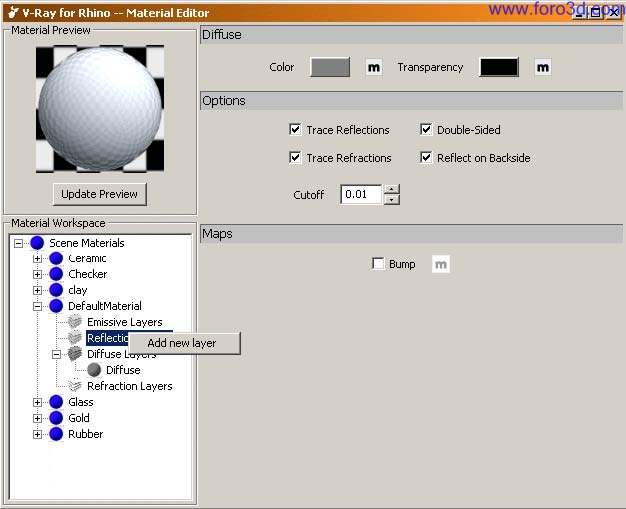



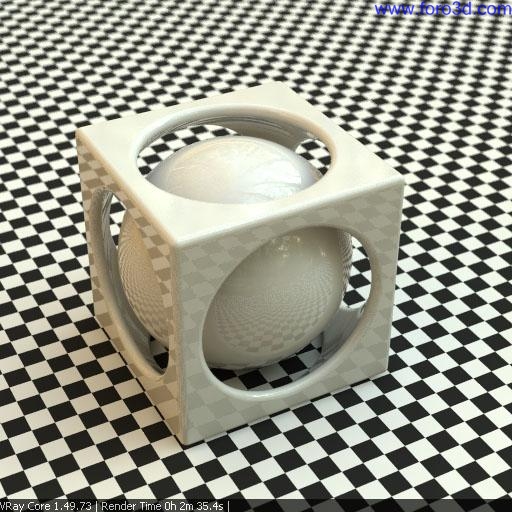



















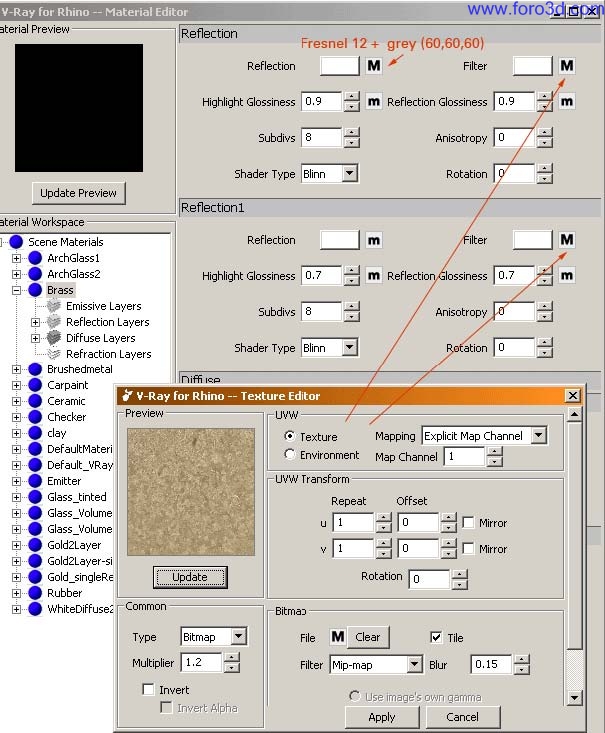








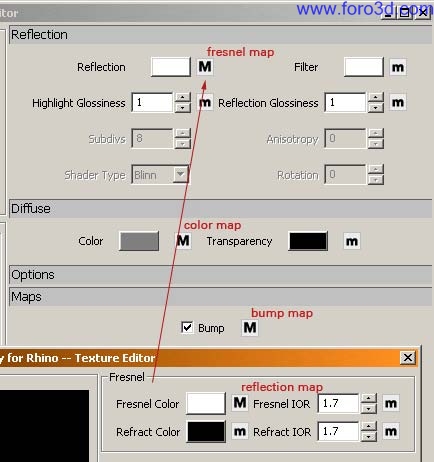







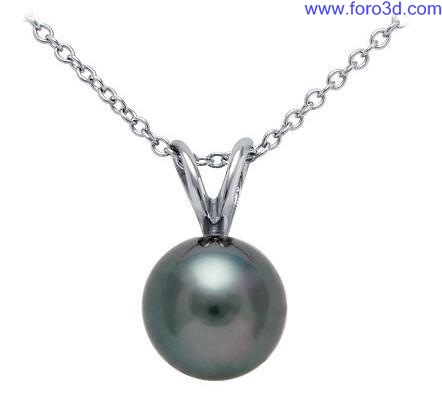



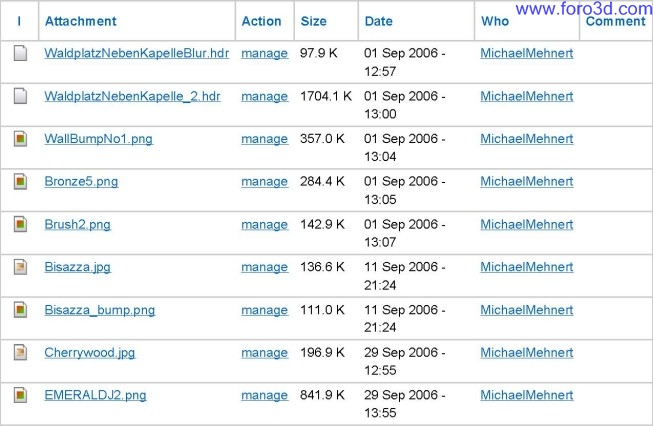

 Citar
Citar